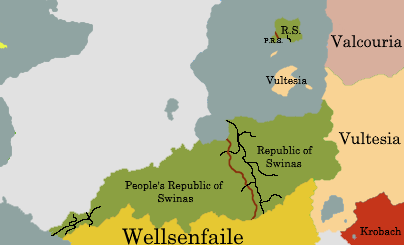Swish Civil War: Difference between revisions
No edit summary |
No edit summary |
||
| Line 17: | Line 17: | ||
| strength1 = 21,380 Infantry | | strength1 = 21,380 Infantry | ||
538 Artillery | 538 Artillery | ||
63 Gunboats | |||
| strength2 = 19,587 Infantry | | strength2 = 19,587 Infantry | ||
489 Artillery | 489 Artillery | ||
75 Gunboats | |||
| casualties1 = 5,289 Casualties | | casualties1 = 5,289 Casualties | ||
| casualties2 = 6,659 Casualties | | casualties2 = 6,659 Casualties | ||
| Line 37: | Line 39: | ||
This action taken by the Socialists would come as a surprise to the Swish government, and 2 weeks after the war started, President Michael Jenkins would resign, and his Vice-President, Berthold Wehner would take his place and begin getting to work on fighting off the Socialists. He would begin by conscripting all men above 18 into the army to fight in the war. He then began a campaign to establish complete control over the Cape Cresta peninsula. | This action taken by the Socialists would come as a surprise to the Swish government, and 2 weeks after the war started, President Michael Jenkins would resign, and his Vice-President, Berthold Wehner would take his place and begin getting to work on fighting off the Socialists. He would begin by conscripting all men above 18 into the army to fight in the war. He then began a campaign to establish complete control over the Cape Cresta peninsula. | ||
==Early War in Nordinsel== | |||
While the war was beginning in the mainland, the small island of Nordinsel wouldn't see very much fighting on the land. However, on the Sea it was different. Many naval battles were primarily fought in Nordinsel. Navy also happened to be what the Swish Socialists had a surplus of. But regardless, the Swish Democratic Navy was still able to fend off some of the naval battles. | |||
Revision as of 18:43, 28 January 2023
The Swish Civil War was a conflict that occurred in the country of Swinas. The war was fought between two factions, the Democratic Union, who supported the existing government, and the Socialist Union, who sought to overthrow the government and establish a new regime. The war began in the year 1921 and lasted 4 years, causing widespread destruction and loss of life. The Democratic Union were eventually able to defeat the Socialist Union, and the country was able to return to a state of peace. The war had a profound impact on the country and its people, and its aftermath is still being felt today.
Situation Before the War
Before the Swish Civil War began, tension between the Democratic parties of Swinas and Socialist parties of Swinas were high. The president before the war, President Michael Jenkins had begun making it an effort to begin riling up the Swish Population against Swish Socialism. Fortunately for the Socialists, the indigenous population of Swinas largely accepted the idea of Swish Socialism, and would go on to help greatly in the war.
The War Begins
Though tension was high between the Democratic and Socialists of Swinas, it would all change in January 21st, when official arrests were conducted on top Swish Socialist officials. This act would result in Swish Socialists protesting in Goatford and demanding the release of the officials. This request would be denied and the Socialists would begin taking more drastic measures. The protests, which were originally seen as harmless quickly turned violent and about 20 casualties were reported just from the protest. And in February 27th, the Socialists would rush to take control of provinces in West Swinas, and afterwards would declare war on the 18th of March, 1921.
Early War on the Mainland
This action taken by the Socialists would come as a surprise to the Swish government, and 2 weeks after the war started, President Michael Jenkins would resign, and his Vice-President, Berthold Wehner would take his place and begin getting to work on fighting off the Socialists. He would begin by conscripting all men above 18 into the army to fight in the war. He then began a campaign to establish complete control over the Cape Cresta peninsula.
Early War in Nordinsel
While the war was beginning in the mainland, the small island of Nordinsel wouldn't see very much fighting on the land. However, on the Sea it was different. Many naval battles were primarily fought in Nordinsel. Navy also happened to be what the Swish Socialists had a surplus of. But regardless, the Swish Democratic Navy was still able to fend off some of the naval battles.
